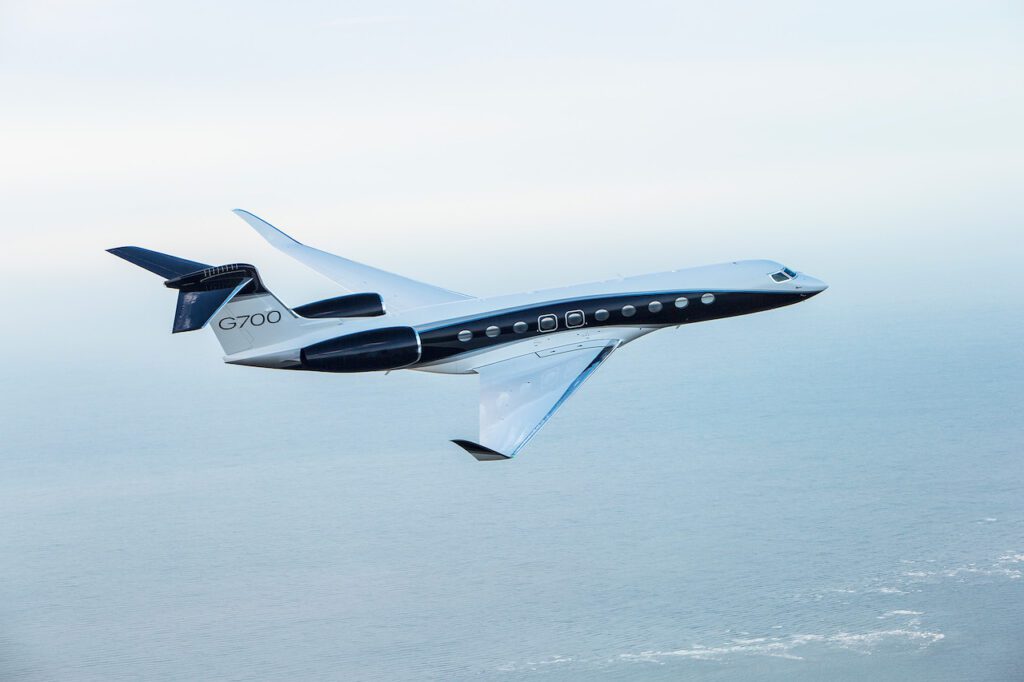
The Gulfstream G700 is nearing the final stages of its flight testing and certification campaign, which could be slightly delayed from Gulfstream’s original timeline due to a new software validation requirement included by the FAA. (Photo courtesy of Gulfstream)
General Dynamics Chairman and CEO Phebe Novakovic told investors and analysts during an earnings call last week that the company’s efforts to obtain type certification on the Gulfstream G700 in preparation could be delayed due to a new software validation process being used by the FAA in its evaluation of the long-range business jet.
The G700 was first launched by Gulfstream at the 2019 NBAA Business Aviation Conference and Exhibition (BACE), capable of flying up to 7,500 nautical miles (nm) at Mach 0.85 or 6,400 nm at Mach 0.90, powered by Rolls-Royce’s Pearl 700 engines. During the General Dynamics earnings call, Novakovic said the G700’s flight test and certification program are ongoing, and that the completion of certification flights with the FAA is typically the “most predictable” part of a new aircraft certification program.
However, there is a new software validation requirement included in the final stages of the G700 certification program that did not exist when Gulfstream first launched the new model.
“This flight test process has a first-time requirement that was not part of our original flight test plan or any prior development effort,” Novakovic said. “It is a model-based developmental software validation, a line-by-line examination of the plane software. The level of effort is considerable, completing 100% of the software validation is the impediment to finishing performance testing by the FAA.”
Novakovic indicated that while the company is still targeting a fourth-quarter timeline on certification of the G700, the addition of the software validation process could cause a three- to six-month delay. There are currently five G700 flight test aircraft involved in the flight testing certification campaign that have completed 2,800 flight hours, with all structural testing now complete as well.
The process is “time and resource intensive” according to Novakovic, who also answered some analyst questions about the process.
“This was an added process that we had not contemplated when we originally laid out our certification plan. And it’s a result of events that are independent of us,” Novakovic said.
The G700’s avionics configuration features the same Symmetry flight deck setup that is used on the G500 and G600, with the same embedded data concentration network as well.
Comments made by Novakovic on the uncertainty around how long it could take the FAA to complete its software validation process for the G700 are similar to those made by Boeing CEO Dave Calhoun two years ago when the company was re-certifying the flight control system for the 737 MAX.
“There is a mountain of documentation that has to be completed,” Calhoun said at the time.
While Gulfstream’s certification requirements are for an all-new aircraft type, the uncertainty on the time required for the FAA is similar.
“It’s more a question of time resources, certainly on the new requirements,” Novakovic said in response to an analyst question about the certification process. “But you saw an increase in R&D this quarter. And it was because that we have this new set of software validation requirements that we need to walk through.”
According to Novakovic, completion of the software validation requirements is also a prerequisite to Gulfstream moving forward with the first flight of its G800—one of two new jets launched last year, the other being the G400—and the eventual certification and validation of that aircraft.